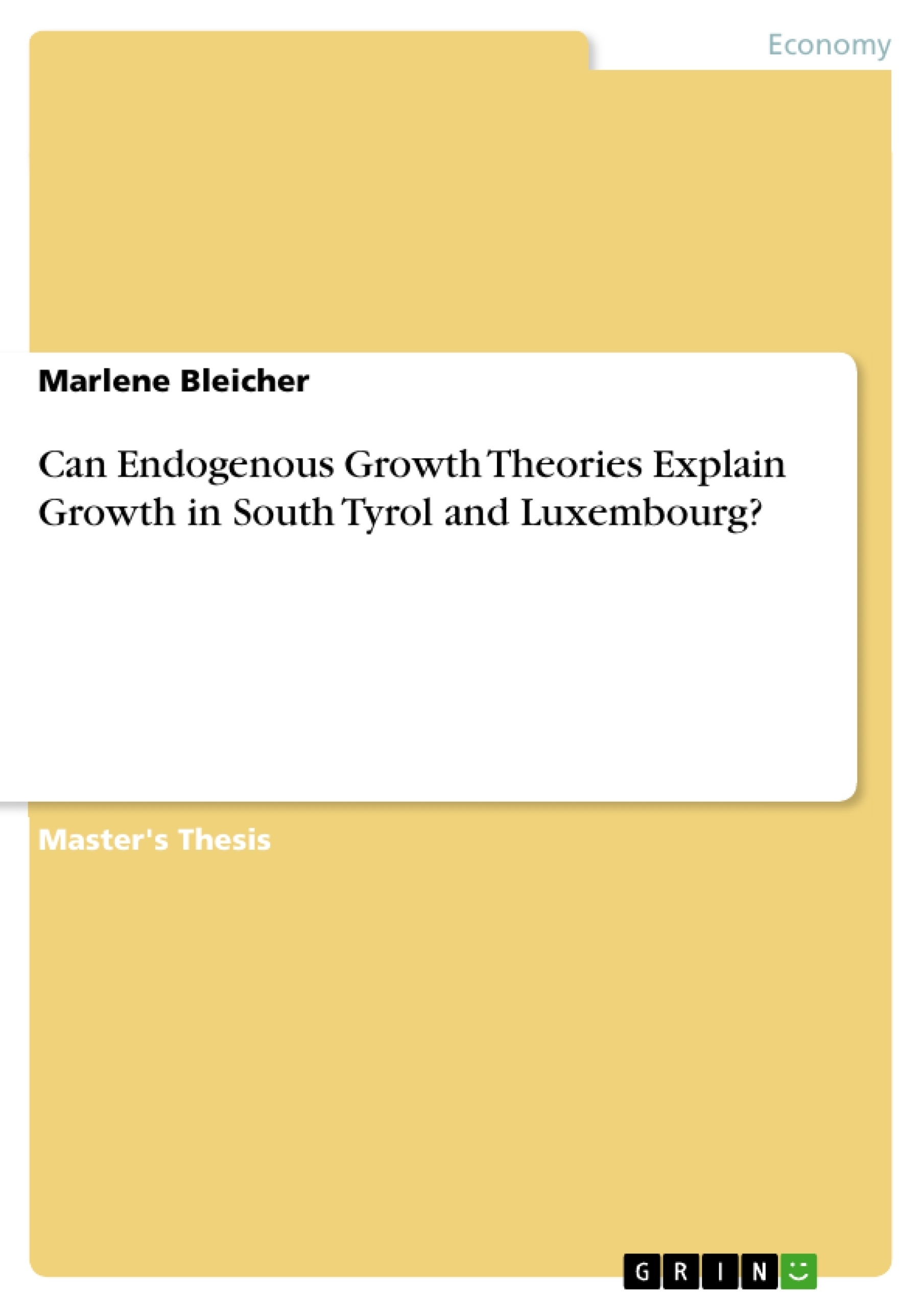This thesis analyzes the two economies of South Tyrol and Luxembourg, questioning whether their economic growth can be explained by concepts of endogenous growth theories.
South Tyrol and Luxembourg are two quite similar economies in terms of size, population, cultural diversity and scarcity of natural resources, but yet very different in matters of economic growth, income per capita and economic specialization, which makes them an interesting sample to test for growth factors.
Since endogenous growth theories, in contrast to neoclassical conceptions, provide a much broader range of tools to handle endogenous technological change, innovation and other factors, they are better suited to analyze growth factors.
Therefore, this thesis first draws a summary on the evolution of endogenous growth theories including an outline of the most important contributions. It is shown that the factor “human capital” plays a major role in most models. Subsequently, the second part of the thesis deals with the economies of South Tyrol and Luxembourg in detail, evaluates historical economic growth, identifies tourism and financial intermediation as their main driving forces and asks whether human capital could be the moving power behind them.
The method of choice for measuring is the country-specific data of the Human Development Index, which is issued every year by the United Nations. They reveal that human capital formation cannot be the answer to the discrepancy between the growth rates of both economies. Consequently, alternative explanations outside endogenous growth theories are sought. Potential causes could be foreign income growth in the case of South Tyrol, and dynamic capabilities together with a capacity of attracting human resources in the case of Luxembourg.
Inhaltsverzeichnis (Table of Contents)
- Abstract
- Zusammenfassung
- Riassunto
- Table of Contents
- List of Equations
- List of Figures
- List of Abbreviations
- 1 Introduction
- 1.1 Object of Analysis: Growth in South Tyrol & Luxembourg
- 1.2 Structure
- 2 The Evolution of Endogenous Growth Theories
- 2.1 Neoclassical Growth Theory with Exogenous Growth
- 2.1.1 The Solow‐Model
- 2.1.2 Shortcomings of Neoclassical Conceptions
- 2.1.2.1 Assumptions
- 2.1.2.2 Convergence Controversy
- 2.2 The Origins of Endogenous Growth Models
- 2.2.1 The Passing of Perfect Competition – 5 Facts
- 2.2.2 Learning by Doing – Arrow’s Approach
- 2.2.3 Adding Human Capital – Lucas’ Approach
- 2.2.4 Knowledge Spillovers & Increasing Returns – Romer’s Approach
- 2.2.4.1 Romer’s Work of 1986
- 2.2.4.2 Romer’s Work of 1990
- 2.2.5 Neo‐Schumpeterian Growth Models
- 2.3 Critical Reflections on Endogenous Growth Theory
- 2.3.1 Critique
- 2.3.2 Practical Relevance
- 3 Matching Growth in South Tyrol & Luxembourg
- 3.1 Background Facts
- 3.1.1 South Tyrol
- 3.1.2 Luxembourg
- 3.2 Data & Methods
- 3.3 Historical Growth Observations
- 3.4 Composition of GDP’s & Characterization of the Economies
- 3.4.1 Tourism in South Tyrol
- 3.4.2 Financial Intermediation in Luxembourg
- 3.5 Analysis of One Major Growth Factor Suggested by EGT – Human Capital
- 3.5.1 Mahroum’s 3D Framework
- 3.5.2 The Cumulative Growth of Human Capital
- 3.5.3 The Human Development Index
- 3.6 Alternative Explanations outside Endogenous Growth Theories
- 3.6.1 The Case of South Tyrol
- 3.6.2 The Case of Luxembourg
- 4 Conclusion
- References
- Appendix
Zielsetzung und Themenschwerpunkte (Objectives and Key Themes)
This thesis examines the economic growth of South Tyrol and Luxembourg, focusing on whether endogenous growth theories can explain their growth patterns. The main objective is to compare the two regions, identifying key factors that drive their economic development. The work explores the role of human capital and its relationship to growth. The main themes include:- The evolution of endogenous growth theories, contrasting them with neoclassical models.
- The limitations of neoclassical growth theory and the emergence of endogenous growth models.
- The importance of human capital as a factor of economic growth.
- The role of tourism in South Tyrol's economic development.
- The significance of financial intermediation in Luxembourg's economic growth.
Zusammenfassung der Kapitel (Chapter Summaries)
This preview does not include summaries of the conclusion or final chapter to avoid spoilers.Chapter 1: Introduction
This chapter introduces the object of analysis, which is the economic growth of South Tyrol and Luxembourg, and outlines the thesis's structure. The chapter also introduces the concept of endogenous growth theory and explains why it is used to analyze these two economies.Chapter 2: The Evolution of Endogenous Growth Theories
This chapter provides an overview of the evolution of endogenous growth theories. The chapter begins with a discussion of neoclassical growth theory, particularly the Solow-Model and its shortcomings. It then introduces the origins of endogenous growth models, highlighting the contributions of various economists like Arrow, Lucas, and Romer. The chapter explores the key concepts like learning by doing, human capital, knowledge spillovers, and increasing returns. Finally, it discusses critical reflections on endogenous growth theory, including its strengths, limitations, and practical relevance.Chapter 3: Matching Growth in South Tyrol & Luxembourg
This chapter dives into the empirical analysis of the two economies. It presents background facts, data, and methods used for analysis. The chapter examines the historical growth observations of both regions, analyzing their GDP per capita and population growth. It then delves into the composition of their GDPs, emphasizing the role of tourism in South Tyrol and financial intermediation in Luxembourg. The chapter explores the relationship between human capital and economic growth in both regions, utilizing Mahroum's 3D framework and the Human Development Index. Finally, it seeks alternative explanations outside endogenous growth theories to explain the growth discrepancies.Schlüsselwörter (Keywords)
This preview focuses on endogenous growth theory, human capital, tourism in South Tyrol, and financial intermediation in Luxembourg. The key terms and concepts include:- Endogenous Growth Theory
- Human Capital
- Tourism Led Growth Hypothesis
- Financial Intermediation
- Dynamic Capabilities
- Human Development Index
- Quote paper
- Marlene Bleicher (Author), 2013, Can Endogenous Growth Theories Explain Growth in South Tyrol and Luxembourg?, Munich, GRIN Verlag, https://www.grin.com/document/267592



